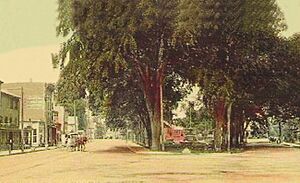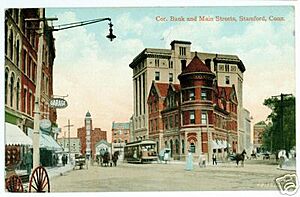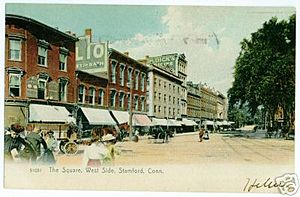History of Stamford, Connecticut facts for kids
Stamford, Connecticut was once home to the Siwanoy Native Americans. European settlers began arriving in the mid-1600s. Stamford grew quickly in the late 1800s and early 1900s because of new industries. It kept growing through the mid-1900s. Later in the 1900s, Stamford's downtown area was rebuilt and modernized. The city's population has continued to grow in the 2000s, with more new buildings in downtown and the South End.
Contents
Stamford's Early History: From Native Americans to a Colony
Stamford was originally called Rippowam by the Siwanoy Native Americans. The first European settlers also used this name. On July 1, 1640, Nathaniel Turner from the New Haven Colony bought the land. He bought it from Siwanoy leaders Wascussee and Ponus. The land included what is now Stamford, Darien, parts of New Canaan, and areas in New York.
The New Haven Colony paid for the land with 12 coats, 12 hoes, 12 hatchets, 12 glass mirrors, 12 knives, two kettles, and four fathoms of white wampum. However, the Siwanoy people may not have fully understood the deal. They did not buy or sell land in the same way Europeans did. The agreement was changed several times later, adding more payments to Ponus's family.
The first European settlers, led by Reverend Richard Denton, arrived in May 1641. They were Puritan families from Wethersfield. They formed "The Rippowam Company" to settle the area under New Haven Colony's rules. On April 6, 1642, the settlement's name changed to Stamford. It was named after a town in Lincolnshire, England, where many early New England settlers came from.
In 1642, Captain John Underhill settled in Stamford. The next year, he represented the town in the New Haven Colony's government. Stamford joined a group called the United Colonies of New England. This group included New Haven, Guilford, Milford, and Southold. After King Charles II of England returned to power, Stamford became a town in the Connecticut Colony in 1662.
Building the Early Town
In the 1640s, a mill was built on the Rippowam River. A wooden meeting house was also built. Stamford's first public schoolhouse was built in 1671. It was a small, simple wooden building. It was made from parts of the old meeting house, which the settlers had outgrown. A new, larger meeting house was built nearby, which also served as the church.
As Stamford grew, people settled further from the town center. In 1673, the Boston Post Road, then called King's Highway, was built. In 1680, people in northern Stamford formed their own town, Bedford. A treaty in 1683 set the border between Connecticut and New York. This meant some of Stamford's land became part of New York.
Reverend John Davenport became Stamford's spiritual leader in 1694. He led the town in a strict way, and few new people were allowed to settle there. After his death in 1731, the church lost some control over town meetings. In 1737, new settlements like Canaan and Middlesex split off from Stamford. Other churches, like Anglican, Baptist, and Methodist, also started in Stamford.
One of the main ways the small colony made money was by trading goods by water. This was easy because Stamford was close to New York.
Stamford During the Revolutionary War
During the American Revolutionary War, many towns near Stamford were attacked by the British. British loyalists from New York often came to Stamford. They would bother and steal from people who supported independence. On July 22, 1781, the British raided Stamford. Because of this, Fort Stamford was built to protect the town.
Stamford in the 1800s
In 1825, steamboat service began in Stamford. Boats traveled to New York three times a week. They carried local goods and about 500 passengers. In 1830, the busy part of Stamford became an official borough.
In 1838, William Betts started Betts Academy, a private school for boys in Stamford. It operated until it burned down in 1908.
Trains and New People Arrive
Train service came to Stamford in 1848. Regular service on the New Haven Line began in 1849. Trains made it easier to get to Stamford. They helped industries grow and brought many immigrants to the city. Stamford's population grew from about 5,000 in 1850 to 11,000 in 1880.
The first big wave of immigrants came from Ireland. Irish immigrants worked in mills, as day laborers, gardeners, and coachmen. A large Irish-American community called "Dublin" grew near the railroad tracks. Some Protestant residents in Stamford were not kind to the Irish-American community. They thought they were too loyal to the Pope. A Catholic church, the Basilica of Saint John the Evangelist, was built in Stamford in 1851. It moved to a larger building in 1886.
Stamford's first school with different grades, the Centre School, opened in 1852. The original wooden building burned down and was replaced by a brick building in 1867. A private school for girls, Catherine Aiken, opened in 1855. Georges Clemenceau, who later became a French leader, taught French there. The school closed in the 1890s. By the 1860s, steamboat service in Stamford stopped because of competition from trains.
In 1873, Stamford High School was created. It was located in a room at the Centre School. Students had to pass an exam to get in. King School, another private school for boys, opened in 1876. It is still in Stamford today, but now both boys and girls attend.
Streetcars and City Growth
Discussions about horse-drawn streetcars in Stamford began in 1866. A company for this service was approved in 1870, but nothing happened. A new approval came in 1886, creating the Stamford Horse Railroad Company. Horse-drawn streetcars started running on January 31, 1887. After going bankrupt in 1888, the company was reorganized. It then got approval to run electric streetcars.
In 1890, a local chapter of the Ancient Order of Hibernians was started in Stamford. It was named after Civil War general Philip Sheridan. In 1893, the central, more crowded parts of Stamford became an official city. Electric streetcars began service in Stamford in 1894, and horse-drawn streetcars were phased out. The New York, New Haven and Hartford Railroad took control of the Stamford Street Railroad Company around 1895.
In 1896, a special building for Stamford's high school was built on Forest Street. By the late 1800s, people from New York built summer homes on the shoreline. Some even moved to Stamford permanently and commuted to Manhattan by train. This became more common later.
Stamford in the 1900s
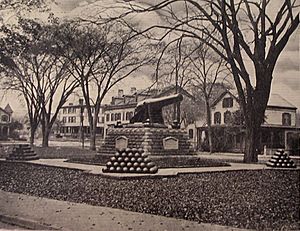
On Memorial Day in 1901, a cannon from the USS Kearsarge was placed in West Park (now Columbus Park). It was a memorial to Civil War veterans. The cannon was made in 1827 and also used on the USS Lancaster. It stayed in the park until 1942, when it was taken away for scrap metal.
In 1904, the Town Hall burned down. A new building was built from 1905 to 1907. It was located on the block formed by Main, Bank, and Atlantic streets. This building became known as Old Town Hall. The mayor's office was there until about 1961. Most city offices moved to 888 Washington Boulevard in 1988.
In 1905, the Consolidated Railway Company bought the Stamford Company. On February 19, 1919, a large fire destroyed the Cove Mill factory. This factory was part of the Stamford Manufacturing Company, located in the Cove section of Stamford.
State Trade School, now called J.M. Wright Technical High School, opened in 1919. The current Stamford High School building was finished in 1928. Stamford is where the electric dry shaver industry began. By 1940, Colonel Jacob Schick employed almost 1,000 workers at his company on Atlantic Street.
The Ku Klux Klan in Stamford
The Ku Klux Klan (KKK) was active in Stamford in the 1920s. The KKK believed in Protestant control of America and was against Black people, Jewish people, and Catholics. Across Connecticut, the KKK was most popular in 1925, with 15,000 members. Stamford was one of the most active areas for the group.
In 1924, one of the largest KKK meetings in the state happened in Stamford. Thousands of KKK members attended. The Stamford Republican Party used its Lincoln Republican Club for KKK activities. The Stamford Advocate newspaper published an advertisement from local Democrats protesting the meeting. The KKK responded with their own ad, pointing out the "un-American" names of some who signed the Democrats' statement.
By 1926, the KKK in Connecticut became weaker. However, small local groups continued in Stamford and other nearby towns for years.
Changes During the New Deal Era
Stamford's electric trolley services stopped on November 11, 1933. This happened partly because of more competition from buses. As more automobiles were used, work began on the Merritt Parkway in 1934. The Merritt Parkway, a major road, opened in 1938.
Downtown Stamford Gets a New Look
On April 15, 1949, the city and town parts of Stamford joined together to form one single city. In the 1950s, as traffic grew, work began on the Connecticut Turnpike, which is now Interstate 95. Interstate 95, a major highway, opened through Stamford in 1956.
UConn Stamford opened in 1951 as a two-year college. Rippowam High School opened in 1961. A third high school, Westhill High School, opened in 1971.

By the mid-1950s, downtown Stamford was looking old and run-down. City leaders wanted to rebuild it. In 1960, the city worked with the F.D. Rich Company to change downtown Stamford. This was a huge project. Over $100 million was spent to buy properties, move families and businesses, tear down buildings, and build new roads.
The redevelopment was very controversial. It involved taking private property and tearing down nine city blocks. About 110 families and 400 businesses had to move. Some residents tried to stop it legally, but they were not successful. Construction began in 1968 with the St. Johns Towers, three round apartment buildings. These towers had 360 apartments and helped house some of the people who were moved. Most old buildings were torn down for the new downtown. This is why Stamford's downtown looks more modern than some other New England cities.
In the 1960s and 1970s, many companies moved their offices to Stamford. The F.D. Rich Company built many office buildings. High Ridge Park, a large office complex, opened in 1967. In 1973, F.D. Rich finished building the headquarters for GTE, a telecom company, and One Landmark Square downtown. The GTE building helped attract other companies to Stamford. In 1977, F.D. Rich built the Stamford Marriott hotel. It has a revolving restaurant at the top with views of Long Island Sound.
Many of these new buildings were criticized for being designed mainly for cars, not for people walking. Buildings along Tresser Boulevard, near Interstate 95, often had only lobbies and garage entrances facing the street. This made them seem unfriendly to pedestrians. These buildings often had parking garages above ground because of the high water table.
F.D. Rich leaders said they designed parts of the area to be hard for pedestrians to access. They defended this even years later. In 1985, Robert Rich, the company president, said downtown Stamford would not be another Madison Avenue. He said corporations wanted a suburban, campus-like setting with easy car access. In 1999, he said the streets were "never meant to be for pedestrians" and that companies moved there for safety. By the mid-2000s, F.D. Rich started changing its properties to be more friendly for people walking.
In 1980, F.D. Rich completed 10 Stamford Forum, a large office building. In 1980, Stamford planned a new train station. Construction began in 1983, and the Stamford Transportation Center opened in 1987. The Stamford Town Center shopping mall, built by F.D. Rich, opened in 1982. Other major buildings built by F.D. Rich in the 1980s included 4, 6, and 8 Stamford Forum.
In 1983, Metro-North workers went on strike for 42 days. During this time, private shuttle and bus services started running from Stamford to New York City. Many of these services stopped after the strike ended.
In the late 1980s and 1990s, new construction slowed down in Stamford. Some companies moved out, and stores closed. F.D. Rich faced financial problems. In 1994, Stamford's South End was named an "enterprise zone." This offered tax breaks to encourage new businesses.
By the late 1990s, Stamford's economy improved. More offices were filled, and the downtown economy became more diverse. A large trading floor for Swiss Bank Corporation was built. UConn Stamford rebuilt its campus. The city's Palace Theater was expanded. Many new apartment buildings were also built. The city and developers also started thinking about pedestrians when planning new projects.
Stamford in the 2000s
On September 11, 2001, nine Stamford residents died in the 9/11 attacks at the World Trade Center. In 2003, the Stamford Transportation Center was updated. In 2005, a 115-room Courtyard by Marriott Hotel opened.
On April 3, 2006, one of Stamford's biggest fires happened in the South End. It started in a piano store and spread to other buildings. Eight businesses were destroyed. Firefighters used a million gallons of water and had to pump water from Long Island Sound. About 200 residents were evacuated.
In August 2006, downtown Stamford had a blackout on a very hot day. Underground electricity cables overheated and caught fire. Many offices had to close. A concert in Columbus Park continued, but many restaurants had to throw out their food.
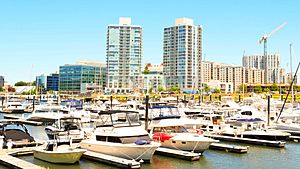
On October 11, 2007, a sudden storm brought 5 inches of rain in about four hours. Streets and basements flooded. About 700 homes lost power. People had to be rescued from cars and homes. The city was later sued by homeowners who said a city employee did not start a pumping station soon enough.
In 2009, F. D. Rich, with partners Donald Trump and Louis R. Cappelli, built the Trump Parc Stamford. This 34-story condominium tower was the tallest building in the city when it opened.
In 2012, Stamford's population became the third-largest in Connecticut, passing Hartford. Much of this growth came from Harbor Point, a big development in Stamford's South End.
In 2016, Stamford's oldest house, the Hoyt-Barnum House, was moved from downtown to a spot next to the Stamford History Center. In 2018, the Cappelli Organization opened the first of its two Atlantic Station towers. The second tower opened in 2021.
In 2020, Stamford's population grew even more, becoming the second-largest city in Connecticut, passing New Haven.
Images for kids
Historic Places in Stamford
Many buildings and areas in Stamford are listed on the National Register of Historic Places. This means they are important for their history or architecture. Here are some of them:
- Agudath Shalom Synagogue
- Benjamin Hait House
- C. J. Starr Barn and Carriage House
- Church of the Holy Name
- Cove Island Houses
- Deacon John Davenport House
- Downtown Stamford Historic District
- Fort Stamford Site
- Gustavus and Sarah T. Pike House
- Hoyt-Barnum House (moved in 2016)
- John Knap House
- Linden Apartments
- Long Ridge Village Historic District
- Main Street Bridge
- Marion Castle, Terre Bonne
- Nathaniel Curtis House
- Octagon House
- Old Town Hall
- Revonah Manor Historic District
- Rockrimmon Rockshelter
- South End Historic District
- St. Andrew's Protestant Episcopal Church
- St. Benedict's Church
- St. John's Protestant Episcopal Church
- St. Luke's Chapel
- St. Mary's Church
- Stamford Harbor Lighthouse
- Suburban Club
- Turn-of-River Bridge
- US Post Office-Stamford Main
- Unitarian Universalist Society in Stamford
- Zion Lutheran Church


